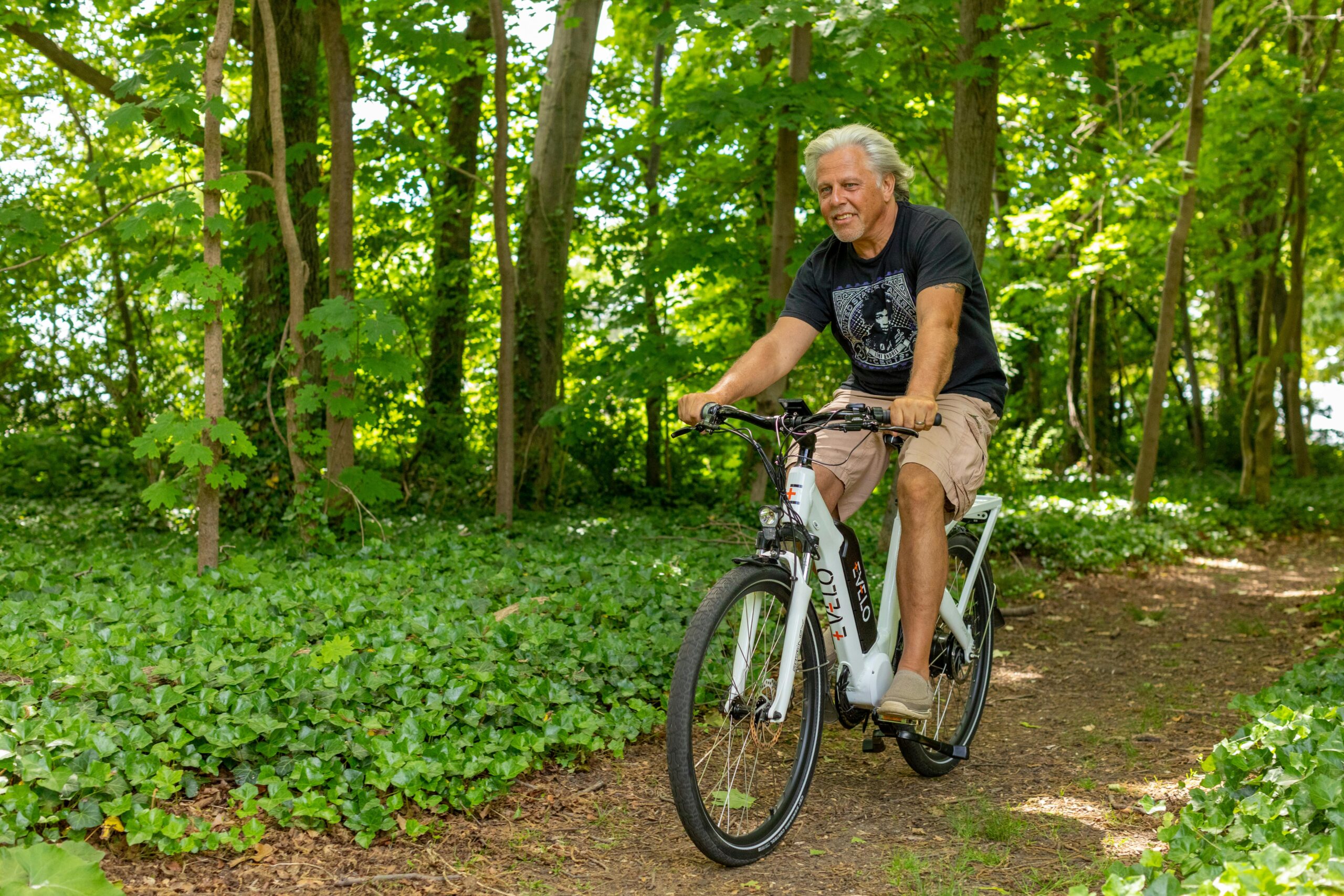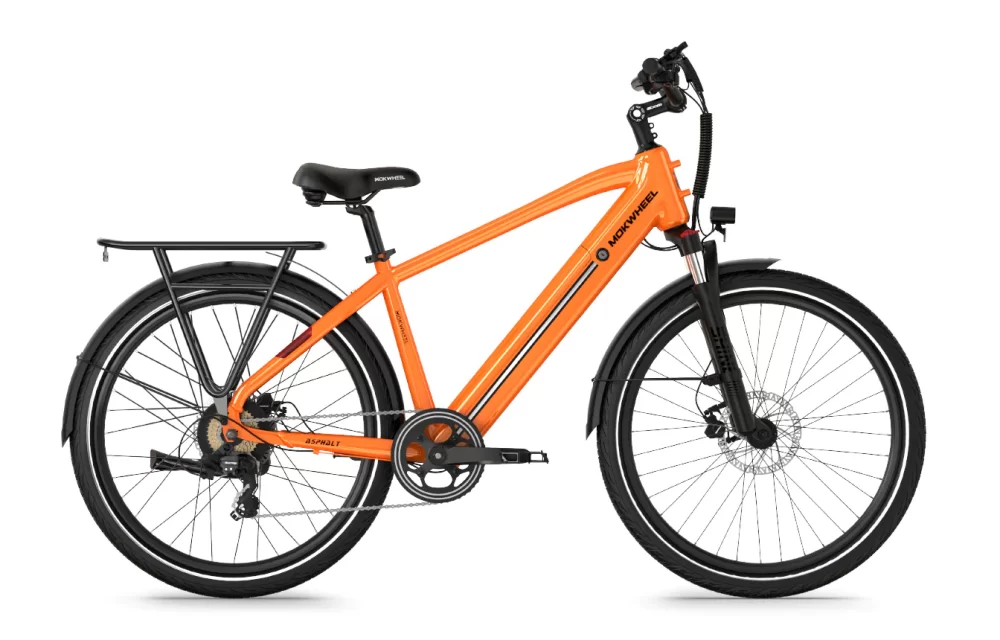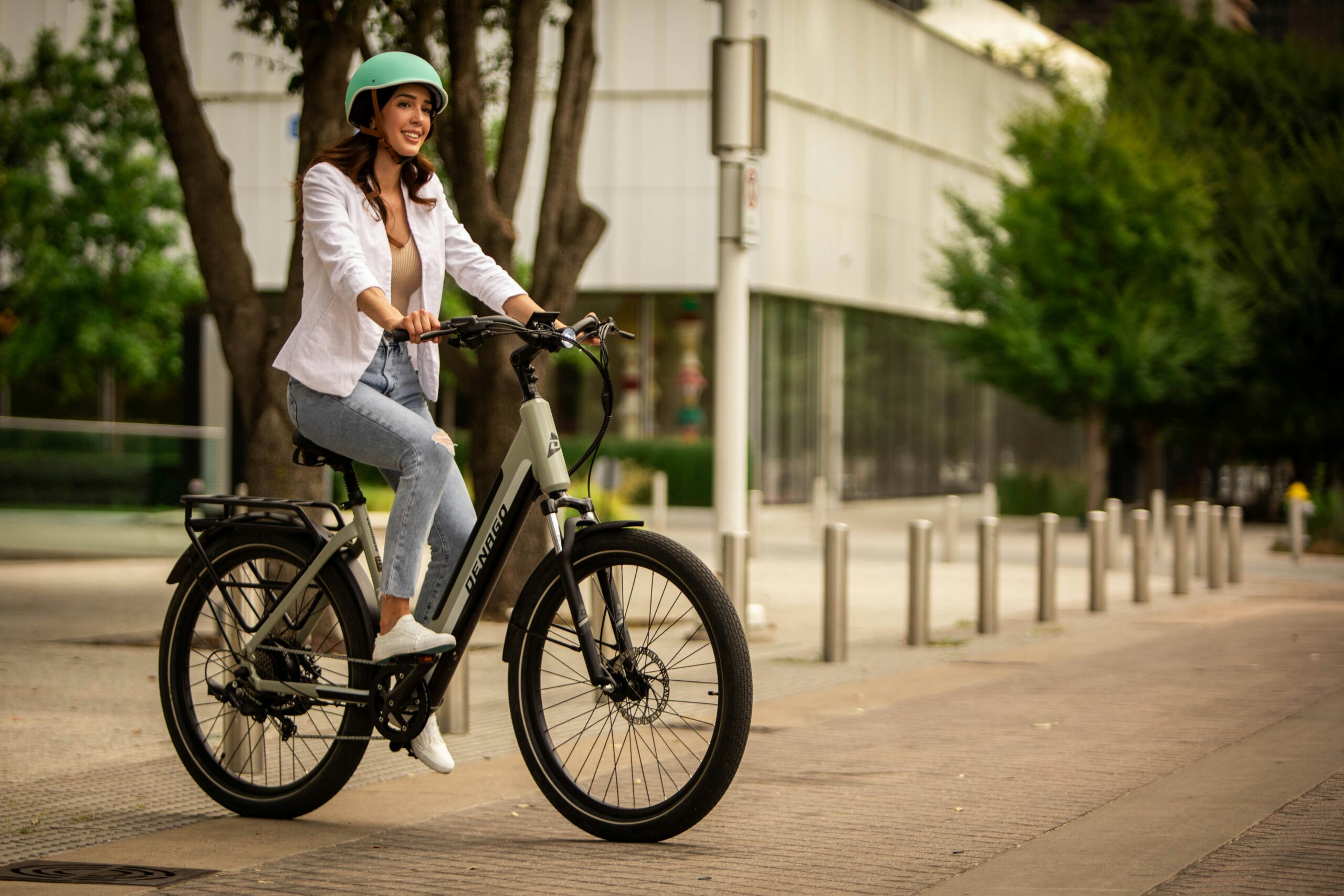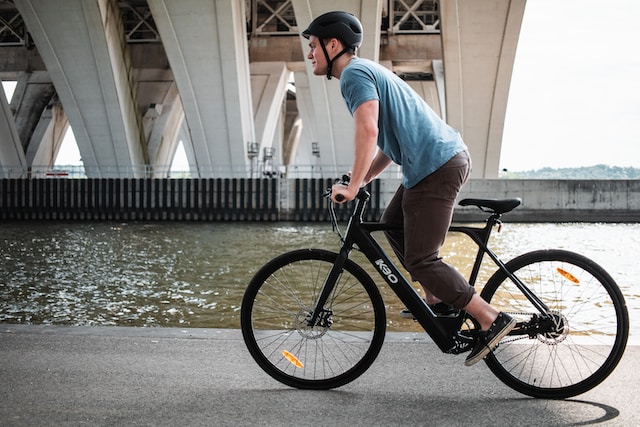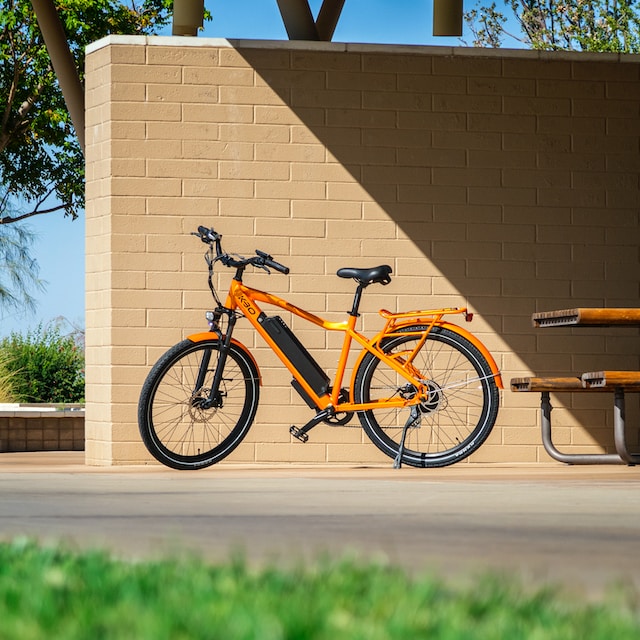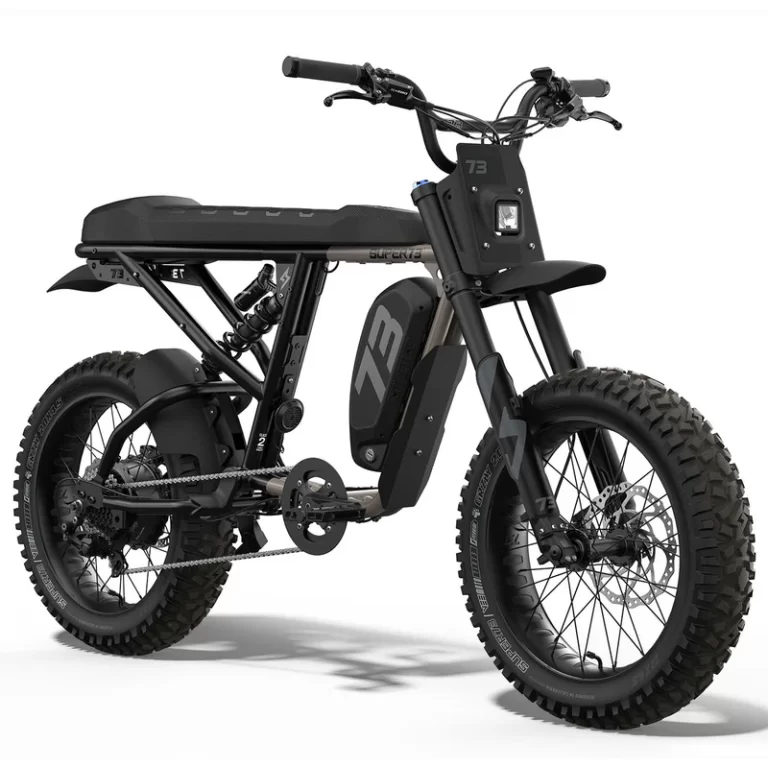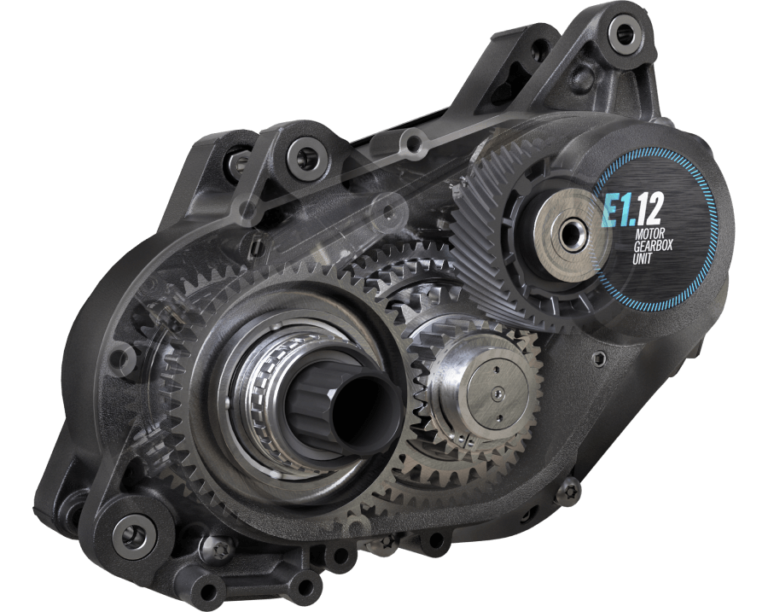Conquer Any Terrain: The Ultimate Guide to Off-Grid E-bike Adventures
Last Updated on June 3, 2024 by Kristina Grant
The great outdoors beckons, and e-bikes are rapidly transforming the way we explore its vast, off-grid territories. Gone are the days when venturing beyond developed paths meant battling tough terrain solely on your own physical power. E-bikes have arrived, offering an electric assist that empowers riders to conquer challenging climbs, traverse longer distances, and unlock a world of off-grid adventures previously out of reach.
This newfound freedom, however, comes with the responsibility to be prepared. Unlike cruising along a paved path, off-grid exploration demands a specific skillset and a well-equipped e-bike. This comprehensive guide equips you with the knowledge you need to navigate off-road adventures with confidence. We’ll delve into essential e-bike skills for mastering various terrains, explore factors to consider when choosing the perfect off-road e-bike, and equip you with practical solutions for charging your e-bike while venturing far from the grid. We’ll also explore the must-have gear for e-bikepacking adventures and the importance of prioritizing safety.
So, whether you’re a seasoned cyclist eager to push your boundaries or a curious adventurer looking for a new way to explore, this guide is your roadmap to conquering the off-grid trails with your trusty e-bike by your side.
Key Takeaways
7 Key Takeaways:
- Develop Off-Road Skills: Mastering basic and technical e-bike skills is crucial for off-grid exploration.
- Choose the Right E-bike: Consider factors like terrain, range, and power when selecting your off-road e-bike.
- Plan for Off-Grid Charging: Explore options like solar panels, wind turbines, or car battery charging (with safety precautions).
- Pack Smart: Prioritize waterproof and lightweight gear for efficient e-bikepacking.
- Prioritize Safety: Equip yourself with essential safety gear like a helmet and protective clothing.
- Embrace Long-Distance Riding: Develop strategies for staying hydrated and comfortable on long e-bike tours.
- Research and Plan: Familiarize yourself with the specific route and potential challenges before heading off-grid
Mastering the Fundamentals: Balance, Braking, and Shifting for Off-Road E-Biking
Conquering off-grid terrain starts with mastering the fundamentals. Here, we’ll delve deeper into three crucial skills: balance and body positioning, braking on loose surfaces, and effective gear shifting. These skills will become the foundation for navigating uneven terrain with confidence and control.
Balance and Body Positioning: Your E-bike’s Best Friend
Imagine your e-bike as an extension of your body. Balance and body positioning are key to maintaining control on off-road adventures. Here’s how to become one with your e-bike:
- Finding Your Center: A centered and balanced stance is essential. Stand with your feet shoulder-width apart, knees slightly bent, and core engaged. This position allows you to absorb bumps and react quickly to changes in terrain.
- Weight Shifting for Control: Learn to shift your weight forward or backward to maintain traction on inclines and descents. When climbing, lean slightly forward to keep the front wheel engaged. Conversely, on descents, shift your weight back slightly for better control and to prevent the front wheel from washing out.
- Steering with Finesse: Off-road steering requires a lighter touch compared to pavement. Avoid jerking the handlebars, and instead, guide the bike by gently leaning in the direction you want to turn while maintaining a centered position.
- Obstacles? No Problem: When encountering obstacles like rocks or roots, anticipate the bump and lift your weight slightly off the saddle as you approach. This allows the wheels to absorb the impact smoothly without compromising your balance.
Braking on Loose Surfaces: A Delicate Dance
Braking techniques on loose surfaces like dirt, sand, or gravel differ significantly from paved roads. Here’s how to modulate your brakes for optimal control:
- The Power of Feathering: Gone are the days of aggressive braking. On loose surfaces, a gentle “feathering” technique is key. Squeeze the brakes lightly with increasing pressure only as much as needed to slow down without locking the wheels. A locked wheel will skid, causing you to lose control.
- Front vs. Rear Brake: The rear brake provides more stopping power than the front brake. However, overuse of the front brake on loose surfaces can cause the wheel to lock and send you flying over the handlebars. A good rule of thumb is to rely more on the rear brake for initial braking and use the front brake for finer control.
- Engine Braking (if applicable): Some e-bikes offer regenerative braking, which uses the motor’s resistance to slow the bike down and potentially charge the battery. While not a substitute for traditional brakes, it can be a helpful tool for maintaining controlled descents, especially when combined with light feathering of the brakes.
RELATED CONTENT – Ebike Braking: Conquer Any Descent
Shifting Gears for Efficiency and Power
Understanding how to utilize your e-bike’s gears in conjunction with the electric motor’s assist is key to conquering inclines and maintaining efficiency on flat terrain.
- Climbing Hills: As you face an incline, shift to a lower gear to provide more leverage and allow the motor to assist you effectively. A lower gear will require more pedal strokes but with less resistance, making it easier to climb.
- Maintaining Momentum: On flat terrain, find a gear that allows you to pedal comfortably without feeling strained. This “sweet spot” will optimize your pedaling efficiency and maximize the range of your battery.
- Working with the Motor: Don’t be afraid to adjust your gears as the motor’s assist kicks in. As you gain momentum, shift to a higher gear to maintain a comfortable pedaling cadence and maximize the motor’s efficiency.
By mastering these fundamental skills, you’ll lay the groundwork for confident and controlled off-road e-bike adventures. Remember, practice makes perfect! Start on smooth, flat terrain and gradually progress to more challenging surfaces as you refine your balance, braking, and shifting techniques.
RELATED CONTENT – No More Dead Phones: Unleash the Power of Dynamo Hub Charging
Conquering Climbs: Mastering E-bike Hill Climbing Techniques
E-bikes transform challenging climbs from daunting obstacles into opportunities for exhilarating ascents. However, proper technique is still essential for conquering hills efficiently and maintaining control. Here’s how to leverage your e-bike’s power and your own skills to become a hill-climbing champion:
Modulating the Electric Assist:
Your e-bike’s electric assist is your secret weapon for tackling hills. Here’s how to use it effectively:
- Finding the Right Assist Level: Most e-bikes offer adjustable assist levels. On steeper inclines, select a higher assist level to provide a significant boost. As the incline lessens, gradually decrease the assist level to conserve battery power while still maintaining momentum.
- Maintaining Cadence: Cadence refers to your pedaling rate. Aim for a consistent and comfortable pedaling cadence while climbing. If you find yourself grinding to a halt with a high assist level, it’s an indication you need to shift to a lower gear. Conversely, if you’re spinning too fast with a low assist level, consider shifting to a higher gear for better power transfer.
Maintaining Traction for a Smooth Ascent:
Traction is key to conquering hills efficiently. Here’s how to ensure your wheels stay firmly planted:
- Body Positioning: Lean forward slightly, shifting your weight over the handlebars. This keeps the front wheel engaged and prevents it from lifting off the ground, which can cause a loss of traction.
- Gear Selection: Shift to a lower gear before tackling the climb. A lower gear provides more leverage, making it easier to pedal uphill without stalling or losing momentum. Remember, it’s better to spin at a higher cadence with a lower gear than to struggle with a high gear and risk losing traction.
- Smooth Pedaling: Maintain a smooth and consistent pedaling motion. Avoid jerky movements that can cause the rear wheel to spin out, especially on loose surfaces.
Mastering Hill Climbing Techniques:
- Standing vs. Sitting: While climbing, some riders find it more efficient to stand up on the pedals. This allows you to use more core muscles and generate additional power. However, seated climbing can also be effective, especially on longer inclines. Experiment and find the position that feels most comfortable and efficient for you.
- Switchbacks: Steep climbs often incorporate switchbacks, which are sharp turns that zigzag up the mountainside. Maintain a low speed and a wide line when navigating switchbacks to avoid losing traction or tipping over.
Resources for Further Exploration:
For a deeper dive into e-bike hill climbing techniques, consider checking out this resource on climbing hills on an ebike.
By mastering these techniques and working in harmony with your e-bike’s assist, you’ll transform hills from dreaded obstacles into opportunities to test your limits and experience the exhilarating thrill of conquering any climb.
RELATED CONTENT – The Best Electric Bikes for Hills
Choosing The Best E-bike for Off-Grid Exploration
Selecting the perfect e-bike for off-grid exploration is crucial for a successful and enjoyable adventure. Just as a road cyclist wouldn’t choose a mountain bike for paved commutes, venturing off-grid requires an e-bike specifically equipped to handle the challenges of rough terrain and potentially long distances. Here, we’ll explore two popular off-road e-bike styles and delve into key considerations for long-range exploration.
All-Terrain vs. Fat Tire: Conquering Different Terrains with Different Styles
When it comes to off-road e-bikes, two main styles dominate the scene: all-terrain and fat tire. Each offers distinct advantages suited for various terrains and riding styles:
- All-Terrain E-bikes:
- Nimble All-rounders: All-terrain e-bikes are known for their versatility. They typically feature knobby tires that provide good traction on loose surfaces but are still narrow enough for efficient maneuvering on tighter trails. These e-bikes often come with full suspension systems, which absorb bumps and improve overall comfort on rough terrain
- Focus on Agility and Handling: All-terrain e-bikes prioritize agility and handling. They are lighter than fat tire bikes and often have a more traditional mountain bike geometry. This makes them ideal for riders who enjoy a more technical riding experience with quick turns and precise handling.
- Fat Tire E-bikes:
- Masters of Soft Terrain: Fat tire e-bikes, as the name suggests, boast super-wide tires that provide exceptional floatation on loose surfaces like sand, snow, or mud. These wide tires offer superior traction and stability, making them perfect for conquering challenging off-grid terrain.
- Comfort and Stability: Fat tire e-bikes often come with full suspension systems for maximum comfort on rough trails. The wider tires and suspension system contribute to a more stable ride, which can be especially beneficial for riders who prioritize comfort and control over agility.
Choosing Your Perfect Match:
Consider the type of off-grid terrain you plan to explore most frequently when selecting your e-bike. If your adventures will primarily involve winding single-track trails with variable terrain, an all-terrain e-bike might be the ideal choice. However, if conquering soft sand dunes or navigating snowy paths is your goal, a fat tire e-bike will provide superior traction and stability.
Long-Range Exploration: Gearing Up for the Distance
Venturing off-grid often means venturing far from the nearest charging point. Here’s what to look for in an e-bike specifically suited for long-range exploration:
- Battery Capacity: Battery capacity is measured in watt-hours (Wh). A higher Wh rating signifies a longer potential range on a single charge. For off-grid adventures, consider an e-bike with a battery capacity of at least 500 Wh, and ideally more depending on the distance you plan to cover.
- Motor Power: Motor power is another crucial factor. While a lower-powered motor might suffice for shorter off-road jaunts, tackling long distances with significant elevation changes might require a motor with more power. This will allow you to maintain a comfortable cruising speed and conquer hills efficiently without draining the battery too quickly.
The perfect balance between battery capacity, motor power, and other features will depend on your specific needs and riding style. Be sure to research and test ride different e-bikes before making your final off-grid exploration companion selection.
All-Terrain E-bikes: Masters of Versatility and Agility
All-terrain e-bikes are the ultimate chameleons of the off-grid world. They excel at conquering a wide range of terrains, from loose gravel paths to moderately technical single-track trails. Here’s a closer look at what makes them shine:
- Versatility is Key: The beauty of all-terrain e-bikes lies in their ability to adapt to various riding conditions. Their knobby tires, featuring a good balance between lug height and tread spacing, provide ample traction on loose surfaces like dirt, gravel, or light snow. Yet, they remain narrow enough to navigate tight corners and maneuver through technical sections of trails with ease
- Full Suspension for Enhanced Comfort: Many all-terrain e-bikes come equipped with full suspension systems, featuring both front and rear shocks. This suspension absorbs bumps and vibrations from the trail, significantly enhancing comfort and control, especially on rough terrain. This allows you to focus on enjoying the ride and conquering challenging sections without feeling every jolt and impact.
- Nimble Handling for a Technical Edge: All-terrain e-bikes are generally lighter than their fat-tired counterparts. This translates to increased agility and maneuverability. They often boast a geometry similar to traditional mountain bikes, with a steeper head tube angle and shorter chainstays. This combination allows for quick steering changes, precise handling on tight corners, and a more responsive ride on technical trails. If you enjoy the thrill of navigating switchbacks and weaving through challenging terrain, an all-terrain e-bike will feel like an extension of your body.
The All-Terrain Rider:
All-terrain e-bikes are ideal for riders who crave adventure and exploration on varied off-grid terrain. They cater to riders who prioritize:
- Agility and handling over pure power.
- The ability to navigate technical trails with precision.
- A comfortable riding experience on moderately rough terrain.
If you envision your off-grid adventures as a thrilling exploration of diverse landscapes, with a healthy mix of technical challenges and scenic cruising, then an all-terrain e-bike might be your perfect match.
Fat Tire E-bikes: Conquering Any Terrain with Confidence
Fat tire e-bikes are the undisputed champions of soft terrain. Imagine gliding effortlessly over sand dunes, carving through deep snow, or powering through muddy trails – fat tire e-bikes make challenging off-grid adventures not only possible but thoroughly enjoyable. Here’s how these robust machines conquer anything you throw their way:
- Masters of Floatation: The defining characteristic of fat tire e-bikes is their incredibly wide tires, typically ranging from 3 to 5 inches in width. These oversized tires act like snowshoes, distributing your weight over a larger surface area. This allows them to float over loose surfaces like sand or snow, preventing you from getting bogged down and ensuring you stay on top of the terrain.
- Superior Traction for Unparalleled Control: The wider footprint of fat tires also translates to superior traction. The increased surface area provides more grip on loose surfaces, giving you greater control over your e-bike and preventing slips and slides, especially on challenging climbs or descents. This enhanced traction is a confidence booster, allowing you to explore new terrains and push your limits without fear of losing control.
- Comfort Reigns Supreme: Fat tires act like built-in suspension systems. Their large air volume absorbs bumps and vibrations from the trail, significantly enhancing comfort on rough terrain. This allows you to ride for longer distances without feeling fatigued or jolted by every rock or root. Fat tire e-bikes are ideal for riders who prioritize a smooth and comfortable journey over technical agility.
- Stability You Can Trust: The wider tire base and lower center of gravity of fat tire e-bikes contribute to their exceptional stability. This is especially beneficial for riders who are new to off-road adventures or simply prefer a more planted and balanced feel. The increased stability inspires confidence, allowing you to focus on enjoying the scenery and navigating the terrain with ease.
The Ideal Off-Grid Partner:
Fat tire e-bikes are the perfect choice for riders seeking to explore challenging off-grid environments. They cater to riders who prioritize:
- Conquering soft terrain like sand, snow, or mud.
- Superior traction and stability for confident handling.
- A comfortable ride that absorbs bumps and vibrations.
If your idea of an off-grid adventure involves traversing unique landscapes, battling the elements, and prioritizing comfort over agility, then a fat tire e-bike will be your trusty companion on every expedition.
RELATED CONTENT – Fat Tire Ebikes vs Traditional Mountain Bikes
RELATED CONTENT – Can Fat Tire Ebikes Handle Bikepacking or Long Distance Touring?
Choosing Your Perfect E-bike Match: Off-Grid Terrain and Beyond
Selecting the ideal e-bike for off-grid exploration goes beyond just the motor and battery. Understanding the type of terrain you’ll be conquering most frequently is paramount. Here’s a breakdown to help you find your perfect match:
Matching Your E-bike to the Terrain:
- Winding Single-Track Trails: If your adventures will primarily involve single-track trails with variable terrain, featuring dirt, gravel, roots, and some loose surfaces, then an all-terrain e-bike is your ideal companion. These versatile machines provide a good balance between traction and maneuverability. Their knobby tires offer sufficient grip on loose surfaces, while their lighter weight and traditional mountain bike geometry allow for precise handling on tight corners and technical sections.
- Soft Terrain Adventures: For riders who crave the challenge of conquering soft terrain like sand dunes, snow, or muddy paths, a fat tire e-bike is the undisputed champion. These robust machines boast super-wide tires that act like snowshoes, ensuring you float effortlessly over challenging surfaces. The wider tires also provide superior traction for confident handling and exceptional stability, inspiring confidence on even the most unpredictable terrain.
Beyond Terrain: Additional Considerations
While terrain is a crucial factor, your e-bike selection should also consider these aspects:
- Riding Style: Do you prioritize agility and technical riding, or do you value comfort and stability? All-terrain e-bikes cater more towards technical riders who enjoy precise handling, while fat tire e-bikes prioritize a smooth and comfortable ride.
- Distance: For longer off-grid adventures, consider a larger battery capacity (ideally above 500 Wh) to ensure you have enough range to complete your journey. Additionally, a more powerful motor might be necessary to tackle long distances with significant elevation changes.
- Budget: E-bikes come in a wide range of price points. Determine your budget beforehand and narrow your search to models that fit comfortably within your range.
Test Ride and Refine Your Choice:
Once you have a better understanding of your preferred terrain and riding style, it’s highly recommended to test ride several e-bikes. This will allow you to experience firsthand how each bike handles and feels, ultimately helping you refine your choice and select the perfect e-bike companion for your off-grid adventures.
RELATED CONTENT – On the Go Charging Strategies for Ebikes While Traveling
Fueling Your Journey: Off-Grid E-bike Charging Solutions
Venturing off-grid doesn’t have to mean leaving your e-bike’s battery on empty. Here, we’ll explore various methods to keep your e-bike charged and ready for adventure, from harnessing the power of the sun to exploring alternative charging options.
Solar Panel Kits for Off-Grid E-bike Charging
Solar panels are a fantastic choice for eco-conscious riders who want to keep their e-bikes juiced up during off-grid adventures. These portable power stations allow you to utilize the sun’s energy to recharge your battery, ensuring you can explore further and experience the thrill of self-sufficient exploration. Here’s a deeper dive into what you need to know about solar panel kits for e-bike charging:
Choosing the Perfect Portable Powerhouse:
- Lightweight and Foldable for Easy Transport: Unlike bulky rooftop solar panels, off-grid e-bike charging kits are designed for portability. They typically consist of one or two weatherproof solar panels that fold up neatly, making them easy to store in your backpack or pannier bags. This compact design ensures they don’t add excessive weight or bulk to your camping gear.
- Size and Wattage: Finding the Right Balance: Solar panel kits come in various sizes, with wattages ranging from around 50 watts to 200 watts or more. The wattage rating determines how quickly your e-bike battery will charge. A higher wattage translates to faster charging times, but also means a larger and potentially heavier kit. Consider the balance between portability and charging speed that best suits your needs. For instance, a 100-watt kit might be ideal for shorter camping trips where you have access to sunshine for most of the day, while a 200-watt kit would be preferable for longer adventures or situations with limited sunlight hours.
Ensuring Battery Compatibility: The Role of the Charge Controller
A crucial component of any solar panel kit is the charge controller. This device acts as the intermediary between the solar panels and your e-bike battery. Its primary function is to regulate the incoming power from the panels, ensuring it’s delivered at a safe and appropriate voltage for your specific e-bike battery. Most off-grid e-bike charging kits come bundled with a compatible charge controller, eliminating the need to purchase them separately.
Setting Up Your Solar Charger: A Simple Process for Sun-Powered Adventures
The beauty of off-grid e-bike charging kits lies in their user-friendly setup. Most kits come with clear instructions, but the general process typically involves:
- Positioning for Optimal Sun Exposure: Unfold the solar panels and find a location with direct sunlight. The more direct sunlight the panels receive, the faster your battery will charge. A sunny clearing or a south-facing slope would be ideal locations.
- Connecting the Panels to the Charge Controller: The solar panels will have designated output ports that connect to the charge controller using the provided cables.
- Connecting the Charge Controller to Your E-bike: The charge controller will have an output port specifically designed to connect to your e-bike’s charging port using the appropriate adapter (usually included in the kit).
With these simple steps, your solar panel kit will be up and running, harnessing the sun’s power to keep your e-bike charged and ready for your next off-grid adventure.
Alternative Charging Solutions: When the Sun Doesn’t Shine
While solar panels reign supreme for harnessing clean and abundant energy, there are other options in your off-grid charging arsenal when the sun decides to take a break. Here’s a look at some alternative methods to keep your e-bike juiced up for adventure:
- Tapping into the Wind’s Power: Portable Wind Turbines
For locations blessed with consistent wind, a portable wind turbine can be a viable alternative to solar panels. These compact windmills convert kinetic energy from wind into electricity. This electricity can then be used to charge your e-bike battery through a compatible inverter, which transforms the wind turbine’s output into a usable voltage for your e-bike.
Things to Consider:
- Wind Consistency is Key: Unlike solar panels that generate power throughout the day, wind turbines rely on consistent wind speeds to produce enough electricity for charging. Research average wind speeds in your planned off-grid location to ensure a wind turbine is a practical option.
- Lower Efficiency Compared to Solar: While wind turbines can be a good alternative, they generally produce less power than solar panels, especially in lighter winds. This means longer charging times for your e-bike battery.
- Car Battery Charging: A Cautionary Tale (Use With Extreme Caution!)
In an absolute pinch, you can use your car battery to charge your e-bike battery. However, this method is fraught with risk and should only be attempted as a last resort, and with extreme caution. Here’s why:
- Safety First: Using an incorrect adapter or exceeding your car battery’s capacity can damage both batteries and ignite a fire. It’s crucial to consult with a qualified electrician before attempting this method to ensure you have the proper knowledge and equipment to do so safely.
- A Temporary Top-Up, Not a Full Charge: Car batteries aren’t designed to provide deep discharges. While they might offer a short top-up charge for your e-bike in an emergency, they likely won’t provide enough power for a full charge.
- Power Banks: A Handy But Limited Solution
High-capacity power banks offer a convenient way to top up your e-bike battery in a pinch. These portable chargers pack a significant amount of power, but their capacity is finite. In most cases, a power bank won’t provide enough power for a full charge, making them best suited for emergency situations or extending your range on short off-grid adventures.
Safety is paramount when dealing with electricity, especially when using alternative charging methods. Always prioritize safe practices and thoroughly research any method before attempting it yourself. When in doubt, consult with a qualified professional to ensure a safe and successful off-grid e-bike adventure.
DIY Off-Grid Charging Station (For the Adventurous Soul):
For the adventurous soul with a knack for DIY projects, constructing a custom off-grid charging station for your e-bike is the ultimate expression of self-reliance. This setup allows you to create your own solar-powered charging haven, independent of the grid and ready to fuel your off-road adventures. However, venturing down this path requires a significant amount of electrical expertise and technical knowledge.
Why DIY? The Advantages of a Custom Station
- Tailored to Your Needs: A DIY approach allows you to customize your charging station to perfectly match your power requirements. You can choose the size and number of solar panels for your desired charging speed, and even integrate wind turbines for additional power generation in windy locations.
- The Satisfaction of Self-Reliance: There’s a unique sense of accomplishment that comes with building your own charging solution. Knowing that you’ve created a system to power your off-grid adventures can be incredibly rewarding.
The Reality Check: Skills and Safety First!
Before diving headfirst into this project, it’s crucial to acknowledge the inherent risks involved in working with electricity. Here’s a reality check to ensure you’re well-equipped for this challenge:
- Electrical Expertise is Mandatory: This project requires a strong understanding of electrical systems, including solar panel connections, battery bank configuration, and safe inverter usage. If you’re unsure about any of these aspects, it’s best to consult with a qualified electrician to avoid potential hazards.
- Safety Always Comes First: Electrical mishaps can have serious consequences. Ensure you prioritize safety throughout the entire process. This includes using proper personal protective equipment, adhering to all electrical codes, and double-checking your connections before powering on your system.
- Professional Consultation is Highly Recommended: Even for the skilled DIYer, consulting with a qualified electrician is highly recommended. A professional can review your plans, ensure your design is safe and efficient, and provide valuable guidance throughout the project.
The Bottom Line: DIY Can Be Rewarding, But Safety is Paramount
Building a DIY off-grid charging station can be a thrilling project for the experienced tinkerer. However, underestimating the technical knowledge and safety precautions required can lead to serious consequences. If you’re unsure about your abilities or hesitant about electrical work, it’s always best to err on the side of caution and seek professional help. Remember, a safe and reliable off-grid charging solution is the foundation for countless future e-bike adventures.
Packing for Adventure: E-bikepacking Essentials
Conquering off-grid terrain on your e-bike requires meticulous planning and packing. Every item you bring needs to be carefully considered to ensure a comfortable, safe, and enjoyable adventure. Here are two crucial aspects to remember when packing for your e-bikepacking expedition:
1. Embrace the Elements: Waterproof Gear is Your Ally
The beauty of off-grid exploration lies in its wild, unpredictable nature. However, this means you need to be prepared for whatever Mother Nature throws your way. Packing waterproof gear is paramount for a successful e-bikepacking trip.
- Waterproof Bags are Essential: Invest in high-quality, waterproof pannier bags, handlebar bags, and a backpack cover. These will shield your belongings from rain, mud, and any other moisture you might encounter on your journey.
- Waterproofing Goes Beyond Bags: A waterproof tent, sleeping bag with a water-resistant shell, and a rain jacket are non-negotiables. These items will ensure you stay dry and comfortable throughout your adventure, even in unexpected downpours.
2. Prioritize Lightweight Essentials: Travel Farther, Effortlessly
While you need to be prepared for anything, keeping your overall weight in check is crucial for e-bikepacking. Unlike traditional bikepacking where weight distribution is essential for handling, e-bikes offer some leeway. However, lighter is still better for efficiency and overall enjoyment of your ride.
- Lightweight Takes Center Stage: Opt for lightweight tents, sleeping bags, and cooking equipment. Look for materials like ultralight backpacking fabrics and consider down sleeping bags for superior warmth-to-weight ratio.
- Multifunctional Gear is a Friend: Every item you pack should ideally serve multiple purposes. Spork-knife combos, sleeping bags with built-in sleeping pads, and mess kits that double as cookware are all great space-saving choices.
When packing for your e-bikepacking adventure, prioritize waterproof gear to keep you protected from the elements, and choose lightweight essentials to maximize efficiency and enjoyment on the trails.
Safety First: E-bike Safety Gear for Off-Road Adventures
Venturing off-grid on your e-bike can be an exhilarating adventure, but safety should always be your top priority. Unlike paved roads, off-road terrain can be unpredictable and unforgiving. The right safety gear can significantly minimize the risk of injuries and ensure you have a worry-free and enjoyable exploration. Here’s a breakdown of essential safety gear for off-road e-bike adventures:
Essential Gear for Off-Road E-bike Riding:
- Helmet: A properly fitted helmet is absolutely non-negotiable. Choose a helmet specifically designed for mountain biking or e-bikes, which offer superior protection compared to traditional road cycling helmets. Look for a helmet with a sturdy shell and a comfortable, secure fit.
- Protective Clothing: Skin abrasions are a common consequence of off-road tumbles. Protect yourself with long pants, a long-sleeved shirt, and sturdy gloves that offer abrasion resistance. Consider investing in protective clothing designed for mountain biking, which often incorporates padding in key areas like the elbows and knees.
- Eye Protection: Branches, dust, and pebbles can pose a serious threat to your eyes. Wear high-quality sunglasses or clear goggles that provide good coverage and shield your eyes from unexpected hazards.
- First-Aid Kit: Be prepared for minor injuries by packing a compact first-aid kit. This should include essential supplies like bandages, antiseptic wipes, pain relievers, and any medications you might require.
Additional Safety Recommendations:
- Hydration Pack: Staying hydrated is crucial, especially during off-road adventures. A backpack with a built-in hydration bladder allows you to easily access water throughout your ride.
- Footwear: Sturdy shoes with good grip are essential for off-road riding. Look for shoes with aggressive treads that provide traction on loose surfaces like dirt, gravel, and mud. Avoid wearing sandals or open-toed shoes, which offer minimal protection.
- Tell Someone Your Plans: Before heading out on your off-grid adventure, inform a friend or family member about your route and expected return time. This way, someone knows where you are in case of an emergency.
By prioritizing safety and equipping yourself with the right gear, you can minimize risks and maximize the enjoyment of your off-road e-bike adventures. Remember, a safe ride is a fun ride!
FAQs
A: Absolutely! E-bikes can be fantastic companions for off-grid exploration. The electric motor assist can help you conquer challenging terrain, cover longer distances, and reduce fatigue, allowing you to explore further and experience more.
A: The ideal e-bike for off-grid adventures depends on the terrain you plan to explore. All-terrain e-bikes are versatile and handle a variety of surfaces, while fat tire e-bikes excel in conquering soft terrain like sand dunes or snow.
A: The distance you can travel on a single charge depends on several factors, including battery capacity, terrain difficulty, and your riding style. Larger battery capacities (ideally above 500 Wh) are recommended for off-grid adventures.
A: Solar panels are a popular and eco-friendly option for charging your e-bike while camping. For windy locations, portable wind turbines can be a viable alternative. In a pinch, you can use a car battery (with extreme caution and proper knowledge) or a high-capacity power bank for short top-up charges.
A: Safety is paramount. Always wear a properly fitted helmet and protective clothing. Prepare for the elements with waterproof gear. Inform someone about your route and expected return time. Pack a first-aid kit and essential tools for minor repairs.
A: Pack light and prioritize waterproof gear. Choose lightweight essentials like a tent, sleeping bag, and cooking equipment. Opt for multifunctional items that serve multiple purposes.
Conclusion:
E-bikes have revolutionized the way we explore the outdoors. Their ability to conquer challenging terrain, coupled with extended range and reduced fatigue, opens a world of possibilities for off-grid adventures. Whether you dream of traversing scenic mountain trails, carving through sandy dunes, or navigating snowy landscapes, e-bikes can be your trusty companion.
By carefully considering the type of terrain you’ll encounter, choosing the right e-bike and charging solutions, and prioritizing safety with essential gear, you can embark on unforgettable off-grid adventures. So, pack your bags, charge your e-bike, and get ready to experience the thrill of self-powered exploration!
Ready to chart your own course and explore the unbeaten path? Research e-bikes suited for your off-grid adventures and start planning your next expedition. The open road (or lack thereof) awaits!
Kristina Grant is not just an enthusiast but a true authority on electric bikes. Nestled in the coastal beauty of Virginia, Kristina has found the perfect backdrop for her passion for electric biking. As a dedicated wife and homeschooling mom, her life revolves around family, faith, and the thrill of adventure.
Originally hailing from Ohio, Kristina's journey with electric bikes began as a curiosity and quickly evolved into a deep expertise. Her blog is a testament to her love for electric biking, combining her fascination for eco-friendly transportation with her coastal lifestyle.
When she's not cruising the beach on her electric bike, you'll find Kristina indulging in her other loves: long walks along the shore, getting lost in a good book, and cherishing moments with her loved ones. With a heart as big as her love for animals, especially cats, Kristina brings a unique perspective to the electric bike world, grounded in her strong faith in God and her dedication to a sustainable lifestyle.
Through her blog, Kristina shares her extensive knowledge of electric bikes, offering valuable insights, tips, and recommendations to fellow enthusiasts. Whether you're a seasoned rider or a newcomer to the electric bike scene, Kristina's blog is your go-to source for all things electric biking, fueled by her passion, expertise, and the scenic beauty of coastal Virginia.

